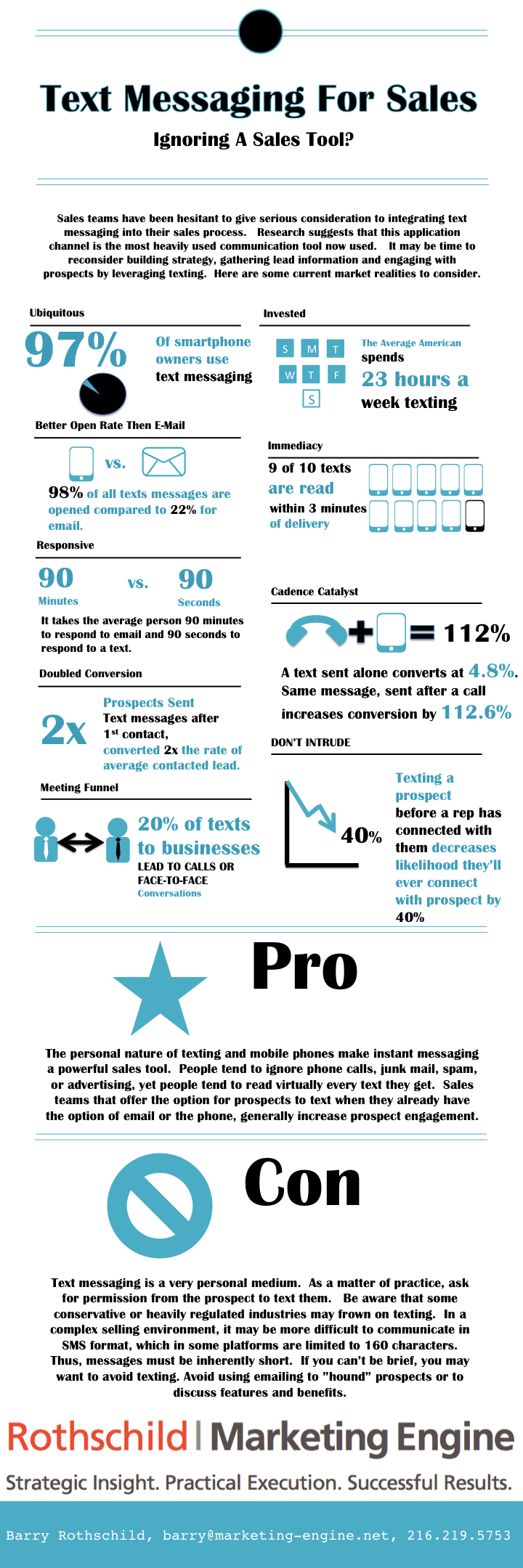|
Are you keeping your sales toolbox well stocked? Are you integrating text messaging into your sales process or sales playbook? I recently had conversations with a few people who are standoffish about using messaging in their outbound sales effort. Some strategists think it’s too personal. If their team would use texting they fear their company will become a nuisance or turn people off. Indeed, one study I read shows that texting a prospect, before you’ve connected with them, decreases the likelihood you’ll ever connect with them by 40%. But not all sales outreach is “cold.” Why wouldn’t you use instant-messaging once a prospect gives you permission to use that venue? Texting is the most ubiquitous mobile application out there. It is used more than actual calling on phones, (98% of all cell phone owners use texting). A text message is bound to be seen; its 97% open rate squashes email’s 22% open rate. And, it promotes lighting fast responses -- people respond to texts within 90 seconds of getting them. So your message is likely illicit a fast reply. (I’ve gathered some research in the accompanying infographic that may be interesting to you. Feel free to circulate it.) Is SMS leading to real quantifiable results? You bet. When used after a first contact has been made, texting doubles the likelihood of converting into a sale. Are you struggling to get that golden first meeting? 20% of texts sent to businesses lead to calls or face-to-face conversations. My guess is that when fax machines were first adopted, people were hesitant to give others their fax number. But facsimiles gradually became the norm for distributing written documents. Do you remember keeping your email addresses and cell numbers close to the vest for fear of people intruding on you? Now think of how ubiquitous those communications tools are. You probably use your cell phone for work more than personal reasons now. Anticipate the professional adoption arc for texting too. Get ahead of the adoption curve. The first rule of even considering using texts in your outreach effort is to actually get cell numbers. As a matter of practice, your team should be acquiring client and prospect cell numbers and adding them to the prospect’s CRM file. Avoid using texts without some acknowledgement or permission from a recipient. Casually asking if you can send out a text it you are running late, or to confirm a meeting is good enough. Explain to prospects how texting will be to the their benefit. You will find that many people welcome it and prefer it. I would avoid using texting exclusively. Rather, use texting as part of a multiplatform approach. Among the great uses for texts are:
Make your “notes” short. No more than 300 characters. Respond to an email question or observation from a prospect with a text. Its faster. Use texting to re-engage with past customers by messaging them about a new promotion or development. The personal nature of texting and mobile phones make instant messaging a powerful sales tool. People tend to ignore phone calls, junk mail, spam, or advertising, yet they tend to read virtually every text they get. Sales teams that offer the option for prospects to text when they already have the option of email or the phone, generally increase prospect engagement.
1 Comment
|
Barry RothschildSeasoned marketer of complex products, services and technologies. Archives
January 2019
Categories |
||||||


 RSS Feed
RSS Feed
